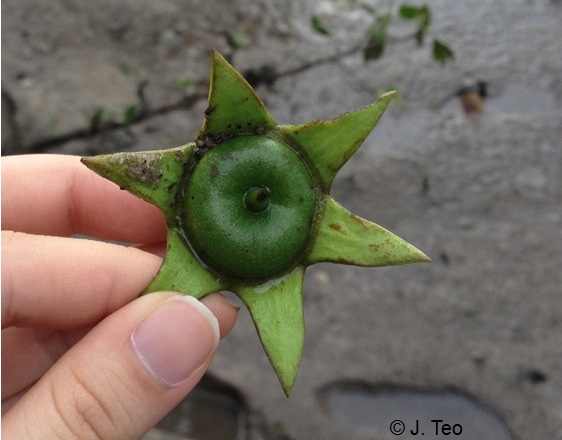 |
| Unripe S.alba fruit found in Mandai mangrove. Photo by Jessica Teo. |
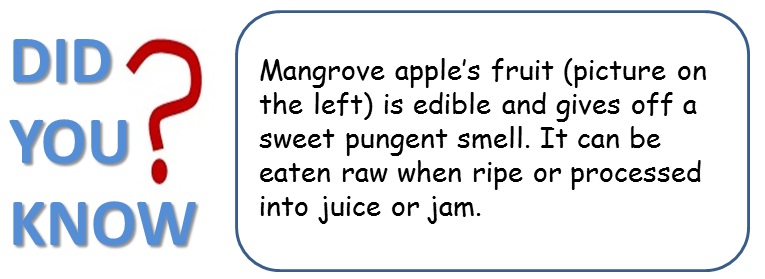
Table of Contents
Name
Binomial: Sonneratia alba J. Smith (1816)Common: Mangrove Apple, Perepat, Bedada, 杯萼海桑, Valko-omenamangrove, Nakshathrakandel
Native Global Distribution
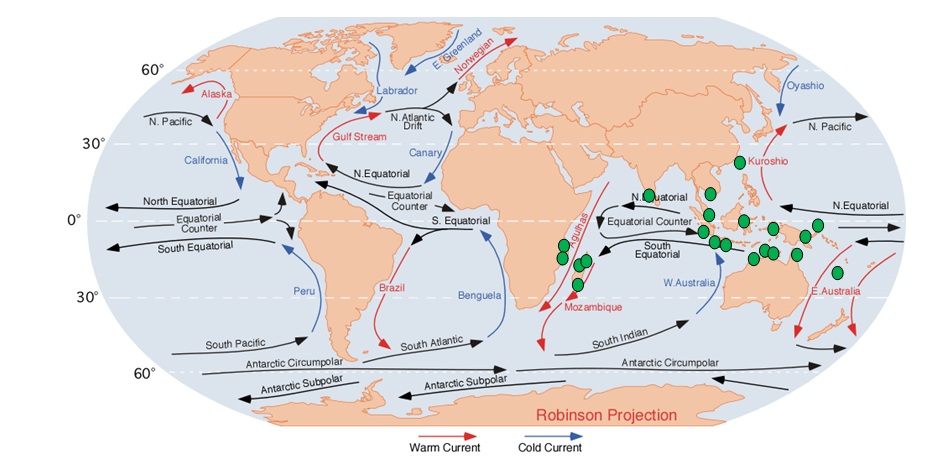 |
| Global ocean currents and the global distribution of S.alba illustrated by green dots. Photo by globalweathersystems.com and edited by Jessica Teo |
Mangrove apple is a widespread pioneer mangrove species found between latitude of 25° N and 25°S (Tomlinson 1986) in Indo-West Pacific region from East Africa (Mozambique), Madagascar through the India (Sundarbans), Southeast Asia, to northern Australia (Daintree River), and Pacific Islands (New Caledonia).
Mangroves distribution in Singapore
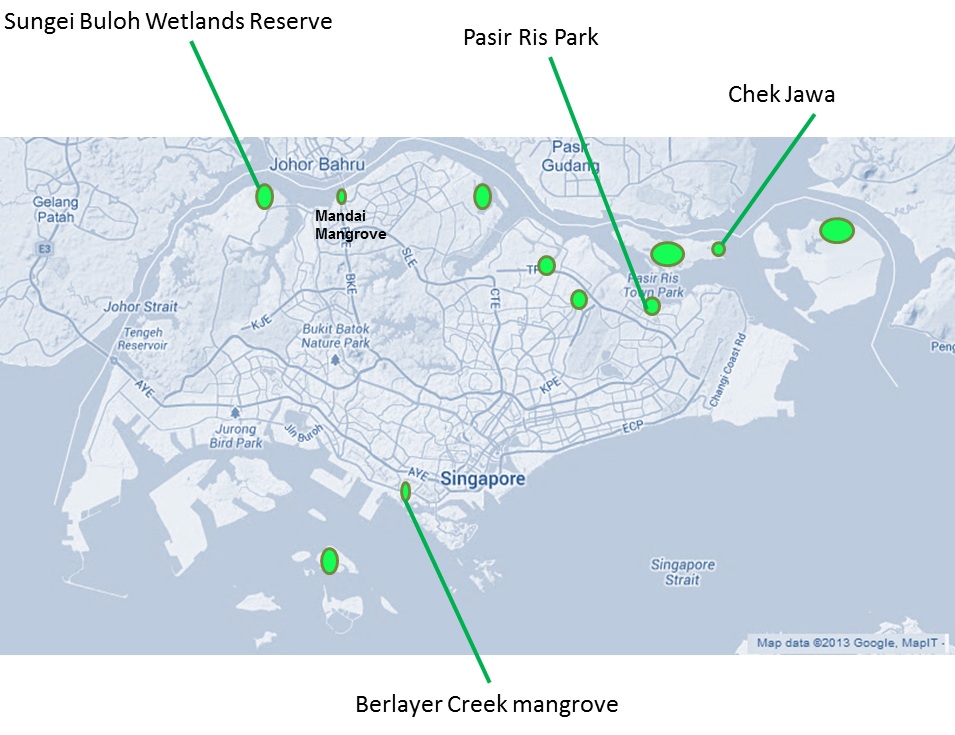 |
| Distribution of mangroves in Singapore in 2013. Image from Google Map, edited by Jessica Teo. |
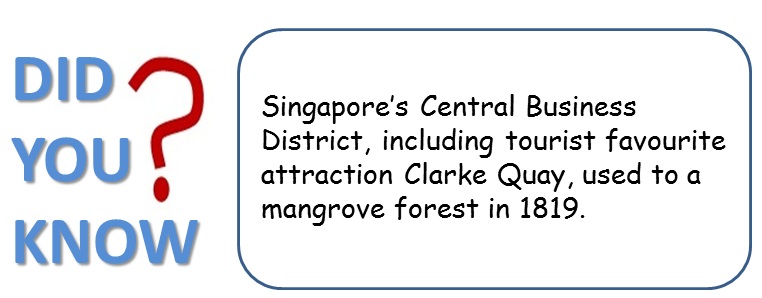
Singapore used to have 13% of its land covered by mangrove forest before 1819. By 1960s, many had been cleared for development; currently, there are only approximately 500ha left in isolated small patches (green dots). All labelled mangroves patches, except for Mandai Mangrove, are accessible to public and readers are encouraged to visit them.
Habitats
 |
| Different views of mangrove habitats during different tide level. Photos by Jessica Teo. |
Mangrove apple is found in low-intertidal habitat in regions of high to moderate rainfall where it receives both fresh and saltwater input. It grows on consolidated mud and sand along river banks, and within sheltered shores of islands where wave energy is low and sedimentation occurs. The soil is often waterlogged, soft and yet compacted which sinks when you step on it. The well compaction of soil has little spaces for atmospheric oxygen resulting in an anaerobic condition. Sulphur oxidising bacteria thrive on decaying plants and animals materials, releasing hydrogen sulphide in the process which gives the smell of rotten eggs that characterise mangrove habitat.
How to Identify
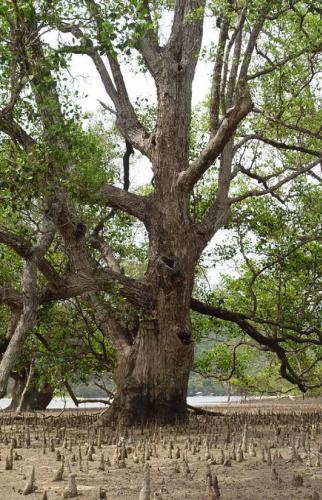 |
| S.alba tree. photo from Langkawi Mangrove Biodiversity Database |
Growth Form: It is a evergreen tree, with a broad, spreading canopy, up to 30 m tall.
its slightly vertical fissured bark distinguished it from other mangrove species.
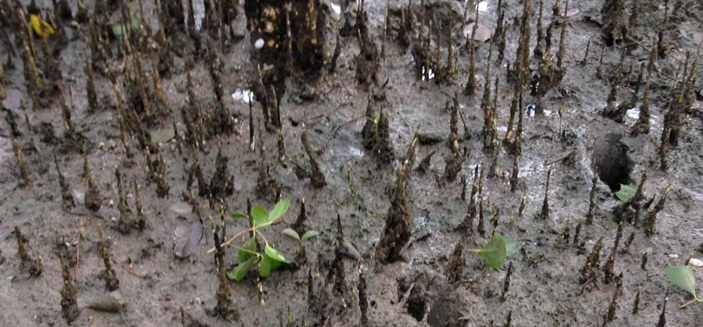 |
| Conical pneumatophores of S.alba. Photo by Jessica Teo. |
Roots:
It bears thick and blunt pneumatophores which are conical roots that emerged out of the mud and grow up to 1 m tall, which are exposed during low tides and submerged during high tide.
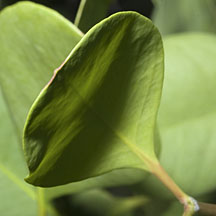 |
| S.alba leaf with a pink mark at the tip of the leaf. Photo by Ria Tan, permission granted. |
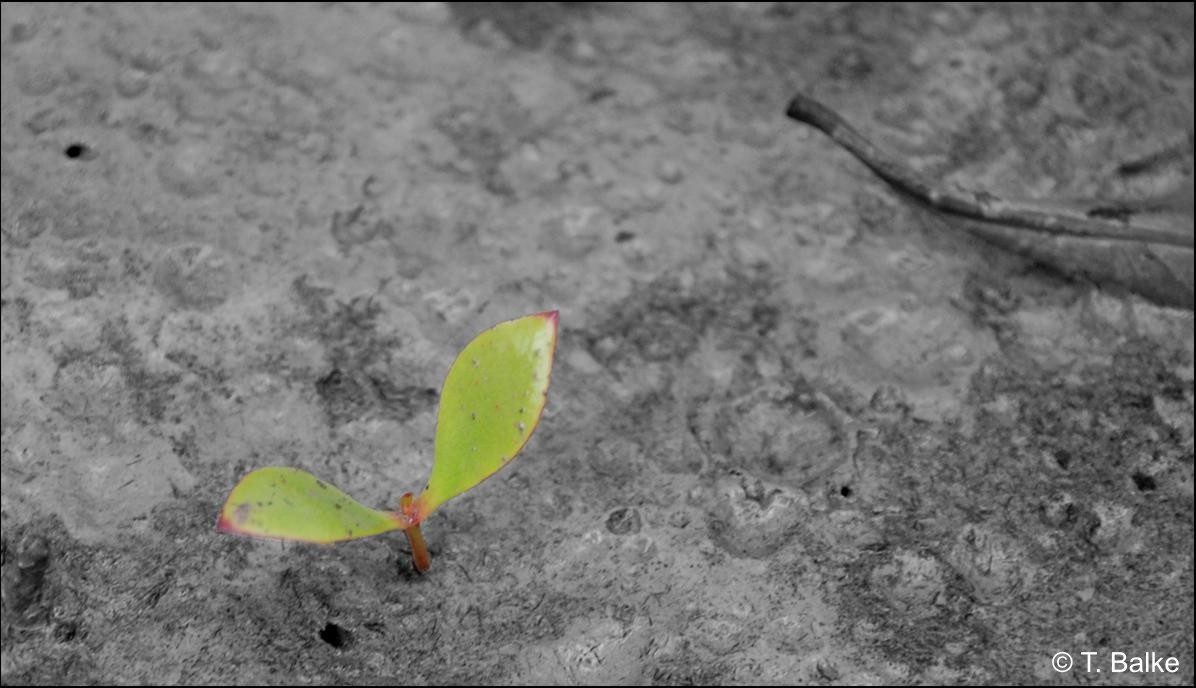 |
| Young S.alba establishing itself on soft active sediments. Photo by Dr Balke permisson pending. |
Foliage: leaves are simple and stalked. Opposite leaves are elliptic to ovate or obovate in shape, with a rounded or broad leaf tip, petiole 5-10 mm long. Lamina is 5-11 cm long and 4-8 cm wide. It bears the characteristic pink mark at the tip of young leaves.
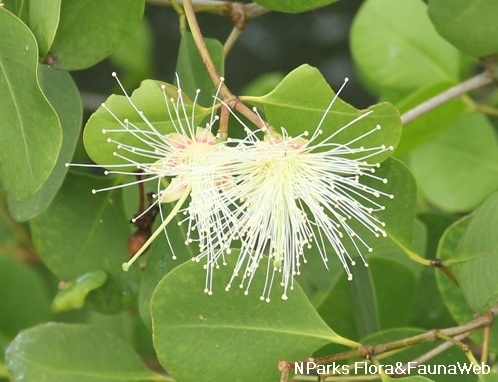 |
| S.alba flowers blooming in cluster. Photo from NParks Flora and Fauna Web. |
 |
| Moving pictures to show the process of S.alba blooming and fruiting. Compiled by Jessica Teo. |
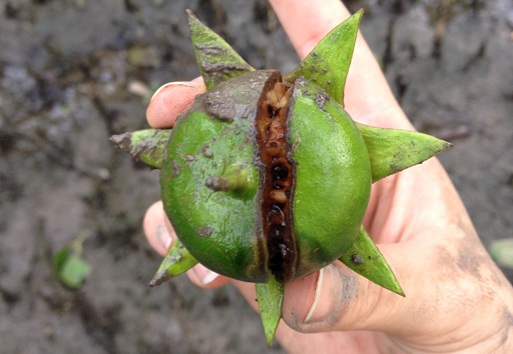 |
| A rotting fruit of S.alba. Photo by Jessica Teo. |
Flowers: Its white petaled flowers, often 6 ribbed, bear numerous white stamens which give it a puffy like appearance. The flowers are borne in clusters of 5-8, and only bloom between dusk to dawn.
Fruits: Its hard fruits resemble fleshy berries that are round and flattened, with a cup-shaped calyx at the base of the fruit. The calyx is reflected backwards from the protruding style and towards the stalk. Mature fruit is approximately 2-4.5 cm across which ripens to green with a dull surface. When ripe, the fruits dropped off the parent tree and start to decay. The decomposing exocarp would break open to release numerous tiny seeds contained inside.
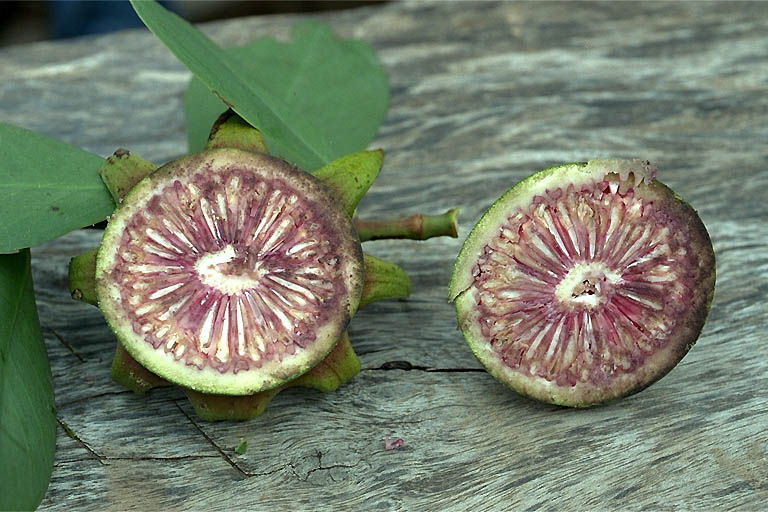 |
| Cross sectional cut of a S.alba fruit. Photo © IFP. Permission granted. |
Seeds: S.alba is a non-viviparous plant, hence it produce 100 – 150 seeds in each fruit which ranges 10-15 mm in length, small in comparison to most other mangroves.
Differentiate
Between S.alba against other Sonneratia spp.
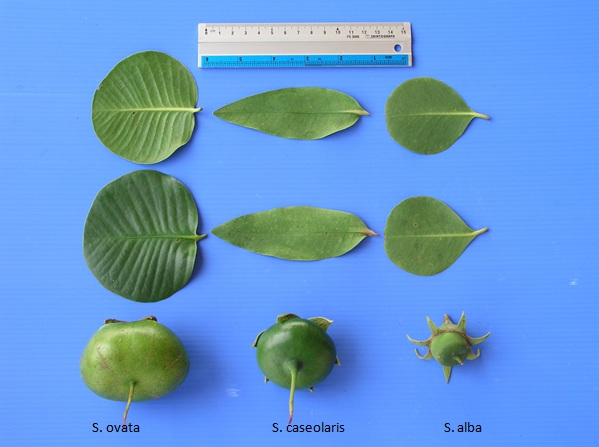 |
| Comapring key features of S.ovata, S.caseolaris and S.alba. Photo by Wan Hong on flickr shared under CreativeCommons. |
Adaptations
Mangrove apple, like many other mangrove species, have several adaptation to cope with the harsh condition of mangrove habitat.
| Adaptation |
Mechanism |
| Salt tolerance |
To avoid the toxic effects of salts, the plant absorbs a large quantity of water for dilution of salt. Retention of water in the leaves give rise to leaf enabling them to store high concentration of salts in tissue. |
| Salt exclusion |
Using ultrafiltration at root level, the plant is able to restrict uptake of salt in high salinity environment. |
| Salt secretion |
1) Leaves have salt glands, which actively secrete salt out of the plant. The salts will then be washed away by rain. Next time if you see shiny crystals on the leaves, lick it to taste! 2) Channel the excess salts in its older leaves which carry it with them when they drop. |
| Pneumatophores |
Pencil roots rising above the soil allows roots to have access to atmospheric oxygen in the anaerobic soil condition. Roots also possess air cavities in root tissues that aid oxygenation of the tissues. |
| Small buoyant seed |
Seeds are white, tiny (12 mm L), sickle-shaped and buoyant. It is able to stay afloat for a period of time which aid in sea dispersal. Its tiny size allows it to enter small creeks and established itself. The seedlings undergo epigeal germination. |
| Fast Growth |
Rapid root development enables it to anchor to the soil and overcome the countering wave action that threatens its survival. The trade-off for fast growth is having low seed-viability; hence a lot of seeds were produced and dispersed each generation. |
Reproduction
The reproductive cycle took approximately 4–5 months in Mangrove apple. Flowering and fruit fall occurred during the dry period and short rainy season respectively.
Flowering and Fruiting season
| Region |
Period |
| Sarawak |
January – April |
| India |
February – May |
| Australia |
May – August |
| Kenya |
July – October |
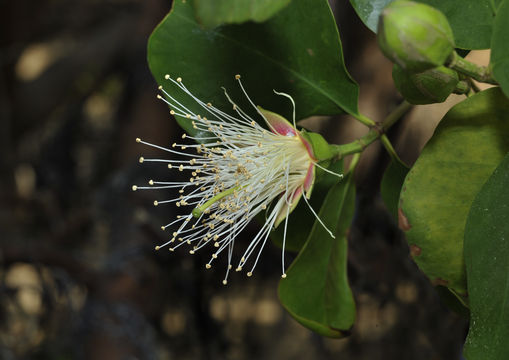 |
| Freshly bloomed S.alba and a unopened flower bud. Photo by Ria Tan. Permission granted. |
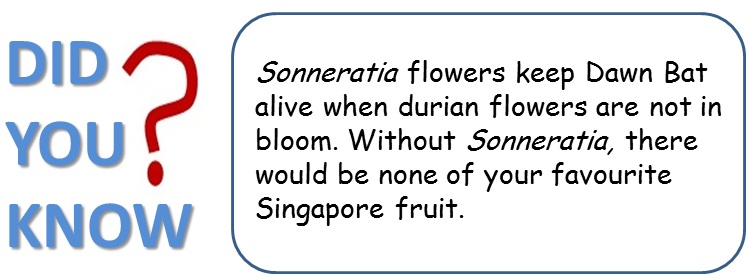
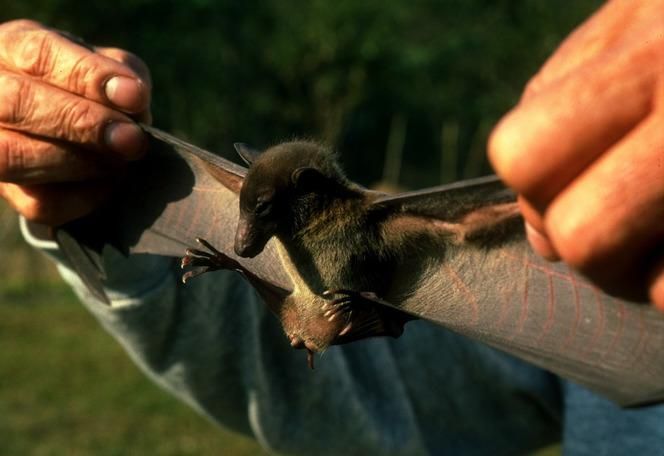 |
| The Dawn Bat (Eonycteris spelaea). Photo by © Phil Myers. Use under CreativeCommons |
Pollination
The fragrant, night-blooming Sonneratia flowers are pollinated mainly by the Dawn Bat (Eonycteris spelaea), the Common Long-tailed Bat (Macroglossus minimus), and the Lesser Short-nosed Fruit Bat (Cynopterus brachyotis). These bats feed on nectar and pollen of flowers and rely mainly on Sonneratia for nourishment. The Dawn Bat in particular which also pollinate commercially important crops such as durians, relies on Sonneratia for food when durian flowers are not in bloom. Mangrove apple is also able to undergo self-pollination when pollinators are lacking.
Hybridisation
Natural hybridisation occurs at a high rate between S.alba, S.ovata and S.caseolaris.
The hybrids in Sonneratia have reduced fitness in comparison with their parental species. The percentage of sterile pollen in S. × gulngai and S. × hainanensis are significantly higher than parental plants as shown by Zhou et al. 2008.
Importance of Mangroves
- Mangroves prevent erosion by stabilising sediments with their roots system. Since Mangrove apple is a pioneer mangrove species, it would be the first line of natural wave breakers that protect coastline against storms and erosion.
- Pioneer species like Mangrove apple is essential in modifying the soil condition first before other mangrove species can colonised.
- Mangroves act as filters for upland runoff. This is important for the health of corals which require clear water for symbiotic zooxanthellae to undergo photosynthesis.
- Mangroves serve as a nursery for many marine organisms such as fish, shrimp, crustaceans and molluscs (see video below). Mangroves provide refuge for juveniles that were too vulnerable to enter the ocean. Eg. Birgus latro (Coconut crab)
- Mangroves produce large amounts of detritus that may contribute to productivity in offshore waters.
- Sonneratia show great medical potential for future drugs. Mangrove apple’s bark showed significant antioxidant cytotoxic and antimicrobial properties against harmful bacteria (M. luteus,Escherichia coli and Pseudomonas aeruginosa and Candida albicans). Furthermore, secondary metabolites (eg Xanalteric acid) were extracted from an endophytic fungus Alternaria species inside Mangrove apple that displayed antibiotic activity against multidrug-resistant bacteria (Staphylococcus aureus).
- Sonneratia spp. are rich in tannin which is an antimicrobial agent used in prevention of dental caries.
- Mangroves have high carbon storage, much higher than tropical rainforest as documented by Donato et al. 2011. Hence mangrove will act as a good blue carbon for climate change mitigation measures.
Especially to Singapore
- Singapore mangroves serve as an important stop-over for migratory birds flying from the northern Eurasian continent to Africa and southern parts of Asia along the East Asian Australasian Flyway to escape winter. Annual migration traffic can reach as high as 12 to 15 thousand million birds.
- Mangrove apple ensures the survival of Dawn Bat, an important animal pollination vector of durian, when seasonal durian flowers are not in bloom. Without Sonneratia, Dawn Bat would not survive long period of starvation between blooming seasons of durian tree. As a result, there would be less of Singapore’s favourite fruit.
This video showed the aquatic biodiversity that mangroves support thus highlighting the important role that they play.
Threats
| Tree fall in Mandai mangrove with Johor Bahru at the skyline. Photo by Jessica Teo. |
 |
| Summary of the threats to mangrove and effects of mangrove loss. Compiled by Jessica Teo. |
There are both natural and man-made threats to mangrove forest, but anthropogenic threats are causing mangroves loss at a rapid rate beyond reestablishment rate. Once these mangroves are lost, restoration of the mangrove forest back to its original vigor is difficult. This section will focus on the man-made threats to mangroves globally.
- Land clearing due to urbanisation and changing the landscape for human use is the greatest threat to mangrove. Land was also cleared for aquaculture, which netted high profits for the first few years, but lost its productivity subsequently; and was abandoned.
- Changing hydrodynamic especially from the increase in shipping around previously low energy shores, is increasing the wave energy causing erosion, tree fall. Increase wave action also act as a physical disturbance that limit seedlings establishment.
- Reservoir construction not only change saltwater environment to freshwater, it also prevent sediments input downstream which is need for accretion and mangrove to self-sustaining.
- Excessive sediments were flushed out of the city during construction results in excessive soil accretion. If sediment deposition is above critical threshold level, it will bury and suffocate mangroves seedlings and prevent colonization.
- When sea level rise, mangroves will naturally migrate landwards towards higher ground to prevent prolong tidal inundation. However, due to human encroachment, mangroves are unable to retreat inland, resulting in coastal squeeze. A slight increment of water level of even 1 cm, would result in huge changes in mangrove habitat; and together with prolong tidal inundation, could literally drown mangrove plants to death.
Conservation

The mangrove apple is listed as Least Concern because there is not enough loss currently to reach threatened category threshold despite overall range declines in many areas due to habitat loss or extraction over the years. Continued monitoring and research is recommended by IUCN, as well as the inclusion of mangrove areas in marine and coastal protected areas. Mangrove apple has been planted in mangrove restoration projects in India and Philippines. Despite being listed as Least Concern, mangrove apple is a keystone species in the mangrove and faced great potential of rapid loss if they were not monitored carefully. If they were lost, many other mangrove species and animals would face great risk of extinction as well.
Etymology
Sonneratia was named after the French naturalist, Pierre Sonnerat (1748-1814), in remembrance of his explorations of New Guinea, Moluccas and China; and his works on the first European description of lychee fruit.
‘Alba’ means white in Latin which refers to the distinctive white stamens and petals of this species.
Synonyms
Chiratia leucantha Montr.
Sonneratia acida Benth.
Sonneratia iriomotensis Masam.
Sonneratia mossambicensis Klotzsch ex Peters
Type Information
Sonneratia alba was first described in Cyclopedia 33 1816 No. 2 by J. Smith.
| Type Status |
Typified Name |
Location |
| Syntype |
Sonneratia acida var. mucronata |
Nationaal Herbarium Nederland |
Taxonavigation
The classification of Sonneratia alba above the species level are as follows.> Plantae
> Tracheophyta
> Magnoliopsida
> Myrtales
> Lythraceae
> Sonneratiaceae
> Sonneratia alba
Phylogenetic Tree
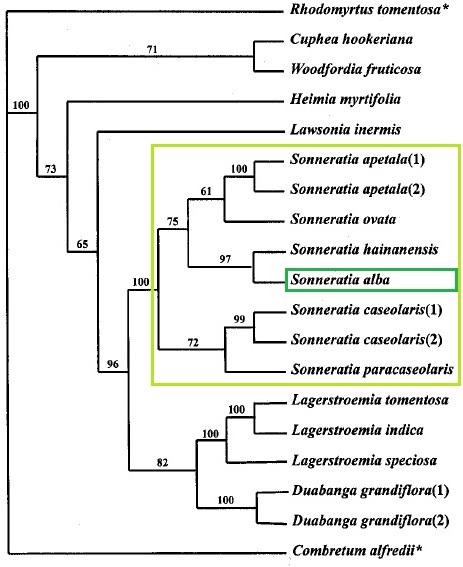 |
| Phylogenetic tree adapted from Shi et. al. 2000 |
Phylogenetic analyses on DNA sequences of the internal transcribed spacer (ITS) and the 5.8S coding region of the nuclear ribosomal DNA were performed by Shi et.al 2000. Maximum parsimony analysis, treating gaps as missing data, generated a single most parsimonious tree which showed that genus Sonneratia (Sonneratiaceae) formed a monophyletic group supported by 100% bootstrap value. The clade of the genus Duabanga (Sonneratiaceae) and Lagerstroemia (Lythraceae) is sister to the clade of Sonneratia. Hence Sonneratiaceae is not a distinct family rank but subset of family Lythraceae.
Links for further reading
Mangrove Watch for identifying between Sonneratia spp and hybrids.
Encyclopedia of Life for general overview of Sonneratia alba.
Mangrove and wetlands wildlife at Sungei Buloh Wetlands Reserve on Sungei buloh Mangrove in Singapore.
Mangroves of Singapore on Mandai mangrove in Singapore
Wild Singapore for awesome photos of mangroves flora and fauna.
Acknowledgement
I would like to thank all the people who had made this page possible, by willingly providing materials and valuable advice. I would like to specially thank Ms Ria Tan, Mr Wan Hong, Phil Myers and Dr Pierre Grard for their wonderful pictures that made my page more attractive; Dr Alison Wee, Dr Edward Webb and Dr Daniel Friess for inspiring me to work on mangroves and loving them. Mr Rick Leong for the field work experience. Special thanks to Constance Teo, Heng Ah Kim and Teo Buck Poo for giving me the support that I can always count on.References
Clifton, E. & Duke, N., 2012. Australian Mangrove and Saltmarsh Resource, Sonneratia. Retrieved Nov 09, 2013, from http://wiki.trin.org.au/Mangroves/Sonneratia
Corlett, R.T., 1991. Vegetation. The biophysical environment of Singapore, Singapore University Press, Singapore, pp134–154.
Coupland, G.T., E.I. Paling & K.A. McGuinness, 2005. Vegetative and reproductive phenologies of four mangrove species from Northern Australia. Australian Journal of Botany, 53: 109–117.
Coupland, G.T., E.I. Paling & K.A. McGuinness, 2006. Floral abortion and pollination in four species of tropical mangroves from northern Australia. Aquatic Botany, 84: 151–157.
Donato, D. C., J. B. Kauffman, D. Murdiyarso, S. Kurnianto, M. Stidham & M. Kanninen, 2011. Mangroves among the most carbon-rich forests in the tropics. Nature Geoscience, 4: 293–297.
Friess, D. A., J. Phelps, R. C. Leong, W. K. Lee, A. K. S. Wee, Sivasothi N, R. R. Y. Oh & E. L. Webb, 2012. Mandai mangrove, Singapore: lessons for the conservation of Southeast Asia’s mangroves. Raffles Bulletin of Zoology,25: 55–65
Gibson, R.N., M. Barnes & R. J. A. Atkinson, 2003. Oceanography and Marine Biology, An Annual Review, Volume: 40. CRC Press, London, 704pp.
India Biodiversity Portal, Sonneratia alba. Retrieved Nov 09, 2013, from http://indiabiodiversity.org/species/show/260063
Kaewpiboon, C., K. Lirdprapamongkol, C. Srisomsap, P. Winayanuwattikun, T. Yongvanich, P.Puwaprisirisan, J. Svasti & W. Assavalapsakul, 2012. Studies of the in vitro cytotoxic, antioxidant, lipase inhibitory and antimicrobial activities of selected Thai medicinal plants. BMC Complementary and Alternative Medicine, 12: 217.
Kathiresan, K. & S. Z. Qasim, 2005. Biodiversity of Mangrove Ecosystems. Hindustan Publishing Corporation, New Delhi, 256pp.
Kjer, J., V. Wray, R. Edrada-Ebel, R. Ebel, A. Pretsch, W. H. Lin & P. Proksch, 2009. Xanalteric Acids I and II and Related Phenolic Compounds from an Endophytic Alternaria sp. Isolated from the Mangrove Plant Sonneratia alba. Journal of Natural Products, 72: 2053–2057.
Mangrove and wetland wildlife at Sungei Buloh Nature Park, Mangrove Apple. Retrieved Nov 01, 2013, from http://www.naturia.per.sg/buloh/plants/sonneratia.htm
Milon, M. A., M. A. Muhit, D. Goshwami, M. M. Masud & B. Begum, 2012. Antioxidant, Cytotoxic and Antimicrobial Activity of Sonneratia alba Bark. International Journal of Pharmaceutical Sciences and Research, 3(7): 2233–2237.
National Parks Singapore, Sonneratia alba. Retrieved Oct 28, 2013, from https://florafaunaweb.nparks.gov.sg/Special-Pages/plant-detail.aspx?id=4739
Shahbudin, S., M. Taher, D. Susanti, H. Qaralleh & A. F. I. B. Awang, 2012. In vitro antimicrobial activity of mangrove plant Sonneratia alba. Asian Pacific Journal of Tropical Biomedicine, 2(6): 427–429.
Shi, S., Y. Huang, F. Tan, X. He & D. E. Boufford, 2000. Phylogenetic Analysis of the Sonneratiaceae and its Relationship to Lythraceae Based on ITSSequences of nrDNA. Journal of Plant Research, 113: 253–258.
Sivasothi, N., 2003. Significance of Singapore’s Mandai mangrove and mudflats. Retrieved Nov 20, 2013 from http://mangrove.nus.edu.sg/mandai/significance.html
The IUCN Red list of Threatened Species, Sonneratia alba. Retrieved Nov 12, 2013, from http://www.iucnredlist.org/details/178804/0
Tomascik, T., 1997. The Ecology of the Indonesian seas Part 2. Periplus Editions (HK) Ltd, Singapore, 1388pp.
Tomlinson, P.B., 1994. The Botany of Mangroves Cambridge Tropical Biology Series. Reprint. Cambridge University Press, Cambridge, 419pp.
Wang, R., Z. Chen, E. Chen & X. Zheng, 1999. Two hybrids of the genus Sonneratia (Sonneratiaceae) from China. Guihaia, 19: 199–204.
Wang’ondu, V. W., J.G. Kairo, J.I.Kinyamario, F.B. Mwaura, J.O. Bosire, F. Dahdouh-Guebas & N. Koedam, 2013. Vegetative and reproductive phenological traits of Rhizophora mucronata Lamk. and Sonneratia alba Sm. Flora, 208 : 522–531.
William, J.M. & J. G. Gosselink, 2011. Wetlands. John Wiley & Sons, New Jersey, 600pp.
Zhou, R.C., X. Gong, D. Boufford, C.I. Wu & S. Shi, 2008. Testing a hypothesis of unidirectional hybridization in plants: Observations on Sonneratia, Bruguiera and Ligularia. BMC Evolutionary Biology, 8: 149.
Contact and Comments
Jessica Teo
blazingstar91@gmail.com
Last modified on November 2013
